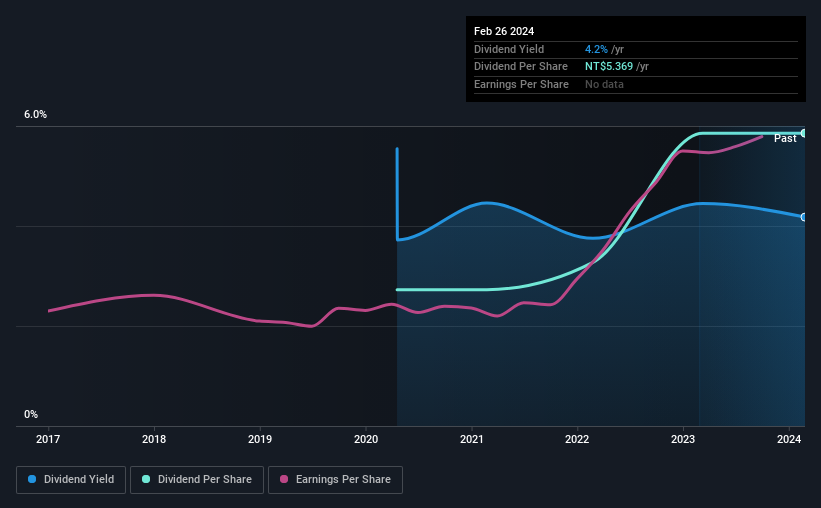Cathay Consolidated (TWSE:1342) Will Pay A Smaller Dividend Than Last Year
Cathay Consolidated, Inc. (TWSE:1342) has announced it will be reducing its dividend payable on the 18th of April to NT$5.00, which is 6.9% lower than what investors received last year for the same period. Despite the cut, the dividend yield of 4.2% will still be comparable to other companies in the industry.
See our latest analysis for Cathay Consolidated
Cathay Consolidated's Earnings Easily Cover The Distributions
We like to see a healthy dividend yield, but that is only helpful to us if the payment can continue. The last payment was quite easily covered by earnings, but it made up 103% of cash flows. While the company may be more focused on returning cash to shareholders than growing the business at this time, we think that a cash payout ratio this high might expose the dividend to being cut if the business ran into some challenges.
Over the next year, EPS is forecast to expand by 9.9%. If the dividend continues along recent trends, we estimate the payout ratio could reach 76%, which is on the higher side, but certainly still feasible.

Cathay Consolidated Is Still Building Its Track Record
The dividend hasn't seen any major cuts in the past, but the company has only been paying a dividend for 4 years, which isn't that long in the grand scheme of things. The annual payment during the last 4 years was NT$2.50 in 2020, and the most recent fiscal year payment was NT$5.37. This means that it has been growing its distributions at 21% per annum over that time. The dividend has been growing rapidly, however with such a short payment history we can't know for sure if payment can continue to grow over the long term, so caution may be warranted.
The Dividend Looks Likely To Grow
Investors could be attracted to the stock based on the quality of its payment history. Cathay Consolidated has impressed us by growing EPS at 22% per year over the past five years. The company doesn't have any problems growing, despite returning a lot of capital to shareholders, which is a very nice combination for a dividend stock to have.
In Summary
Overall, it's not great to see that the dividend has been cut, but this might be explained by the payments being a bit high previously. With cash flows lacking, it is difficult to see how the company can sustain a dividend payment. This company is not in the top tier of income providing stocks.
Investors generally tend to favour companies with a consistent, stable dividend policy as opposed to those operating an irregular one. Meanwhile, despite the importance of dividend payments, they are not the only factors our readers should know when assessing a company. Taking the debate a bit further, we've identified 2 warning signs for Cathay Consolidated that investors need to be conscious of moving forward. Looking for more high-yielding dividend ideas? Try our collection of strong dividend payers.
New: AI Stock Screener & Alerts
Our new AI Stock Screener scans the market every day to uncover opportunities.
• Dividend Powerhouses (3%+ Yield)
• Undervalued Small Caps with Insider Buying
• High growth Tech and AI Companies
Or build your own from over 50 metrics.
Have feedback on this article? Concerned about the content? Get in touch with us directly. Alternatively, email editorial-team (at) simplywallst.com.
This article by Simply Wall St is general in nature. We provide commentary based on historical data and analyst forecasts only using an unbiased methodology and our articles are not intended to be financial advice. It does not constitute a recommendation to buy or sell any stock, and does not take account of your objectives, or your financial situation. We aim to bring you long-term focused analysis driven by fundamental data. Note that our analysis may not factor in the latest price-sensitive company announcements or qualitative material. Simply Wall St has no position in any stocks mentioned.
About TWSE:1342
Cathay Consolidated
Operates as a contract manufacturer of technical fabrics and finished goods in Taiwan.
Flawless balance sheet second-rate dividend payer.
Similar Companies
Market Insights
Community Narratives


Recently Updated Narratives

Constellation Energy Dividends and Growth

CoreWeave's Revenue Expected to Rocket 77.88% in 5-Year Forecast

Bisalloy Steel Group will shine with a projected profit margin increase of 12.8%
Popular Narratives


MicroVision will explode future revenue by 380.37% with a vision towards success


NVDA: Expanding AI Demand Will Drive Major Data Center Investments Through 2026



